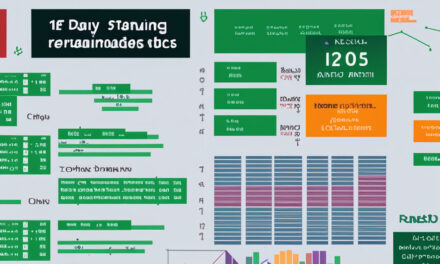In the world of Forex portfolio management, understanding the principles of correlation and diversification is essential. With countless currencies and market variables to consider, it can be challenging to navigate the complexities of this financial landscape. However, by leveraging these strategies effectively, investors can mitigate risk, achieve balance, and optimize their portfolio management.
Understanding Correlation for Forex Portfolio Management
Correlation lies at the heart of Forex portfolio management. It quantifies the relationship between different currency pairs and helps investors determine how they move in relation to each other. By analyzing correlation, traders can identify opportunities for profit and manage risk more effectively.
Not all currency pairs have the same correlation, and understanding this variance is crucial. Positive correlation indicates that two currency pairs tend to move in the same direction, while negative correlation suggests that they move in opposite directions. By diversifying their portfolio with a mix of positively and negatively correlated assets, traders can balance risk and potentially increase returns.
Furthermore, it’s important to recognize that correlation is not fixed and can change over time. Factors such as economic indicators, geopolitical events, and market sentiment can influence the correlation between currencies. Staying informed and adapting to changing correlations is vital for successful Forex portfolio management.
Exploring the Benefits of Diversification in Forex Portfolio Management
Diversification is a fundamental strategy in portfolio management, and it holds great significance in Forex trading. By spreading investments across various currency pairs, traders can minimize the impact of potential losses from individual assets. This is because not all currencies will move in the same direction at the same time, creating opportunities for gains even during market downturns.
Furthermore, diversification allows traders to take advantage of different economic cycles and market trends. By including currencies from various regions and economies, investors can position themselves to benefit from global developments. This broader perspective reduces the risk associated with putting all investments in a single currency or geographic area.
Diversification also enables traders to capitalize on specific currency movements. If one currency pair is experiencing a downturn, another one may be on the rise. By diversifying their portfolio, investors can take advantage of these market fluctuations and potentially improve their overall returns.
Balancing Risk Through Correlation and Diversification in Forex
One of the primary objectives of Forex portfolio management is risk management. By combining correlation and diversification strategies, traders can achieve a balanced approach to risk.
Correlation helps to identify assets that may move together, enabling investors to adjust their portfolio to minimize the impact of adverse market conditions. By including negatively correlated pairs, traders can potentially offset losses in one currency with gains in another. This balance allows for smoother equity curves and helps traders weather market volatility.
Diversification serves as a safety net against market downturns. Since currencies often move independently, diversifying investments across multiple currency pairs reduces the impact of single currency fluctuations. This broader approach minimizes the risk of significant losses and helps maintain a stable investment portfolio.
Analyzing Correlation of Currencies in Forex Portfolio Management
Analyzing the correlation between currency pairs is a vital aspect of Forex portfolio management. By understanding the relationships between currencies, traders can make informed decisions on how to diversify their investments.
There are various tools and techniques available to analyze currency correlation. One common approach is to use correlation coefficients, which measure the statistical relationship between two variables. Values close to +1 indicate a strong positive correlation, while values close to -1 suggest a strong negative correlation.
Traders can also visualize correlation through scatter plots or heatmaps. These visual representations provide a comprehensive overview of the relationships between currency pairs and offer insights into potential trading strategies.
Leveraging Diversification Strategies in Forex Portfolio Management
Diversification strategies in Forex portfolio management encompass more than just spreading investments across various currency pairs. Traders can also diversify by trading different forex instruments or incorporating other asset classes, such as commodities or indices.
Using different trading strategies is another form of diversification. Implementing a mix of short-term and long-term trading approaches, as well as employing different technical and fundamental analysis methods, allows traders to adapt to changing market conditions and capture a broader range of opportunities.
Additionally, diversifying across timeframes can help manage risk. By holding positions over various time horizons, traders can reduce the impact of short-term fluctuations and take advantage of long-term trend movements.
Mitigating Risk Through Correlation and Diversification in Forex
Mitigating risk is a critical aspect of successful Forex portfolio management. By harnessing the power of both correlation and diversification, traders can protect their investments from significant losses.
Correlations can alert traders to potential risks associated with specific currency pairs or market conditions. By monitoring the correlations among their portfolio’s assets, investors can make informed decisions to reduce exposure to volatile currencies or minimize risk during certain economic events.
Diversification acts as a safety net by spreading investments across multiple assets. This strategy lowers the impact of adverse movements in any single currency or market, protecting the portfolio from severe losses.
Optimizing Forex Portfolio Management Through Correlation and Diversification
Optimizing Forex portfolio management requires finding the right balance between correlation and diversification strategies. By fine-tuning these approaches, traders can enhance their portfolio’s performance and minimize risk.
Regularly reassessing and adjusting correlation levels is essential. As market dynamics change, the correlations between currency pairs can fluctuate. Traders should stay vigilant and adapt their portfolios accordingly to leverage changing market conditions to their advantage.
When diversifying, investors should carefully consider the correlation tendencies of the currency pairs they choose. A balanced mix of positively and negatively correlated assets can help build a robust and resilient portfolio.
Utilizing Correlation and Diversification in Forex Portfolio Management
By incorporating correlation and diversification into Forex portfolio management strategies, traders can make more informed decisions and minimize risk. These techniques offer a comprehensive framework for navigating the complexities of the market, regardless of its volatility.
Understanding the correlation between currency pairs allows traders to identify opportunities, manage risk, and optimize their investments. Diversification, on the other hand, enables them to spread risk across multiple assets and capture a broader range of market movements.
By combining these powerful strategies, traders can achieve a well-balanced portfolio that withstands market fluctuations and enhances the potential for long-term success.
Designing Forex Portfolio Management Strategies Using Correlation and Diversification
Designing effective Forex portfolio management strategies requires a thoughtful integration of correlation and diversification techniques. Traders must carefully assess their risk appetite, investment goals, and market conditions to construct a robust and personalized portfolio.
The first step in designing these strategies is to analyze the individual risk tolerance and investment objectives. Risk-seeking traders may choose to allocate a higher proportion of their portfolio to more volatile currency pairs, such as emerging market currencies, while risk-averse traders may prefer the stability of major currency pairs.
Once risk tolerance is determined, traders can then assess the correlation tendencies among different currency pairs. By selecting a mix of positively and negatively correlated assets, investors can strike a balance between risk and return potential.
In addition to currency correlation, diversifying across asset classes can further enhance portfolio performance. Including commodities, indices, or other financial instruments can provide additional opportunities and reduce the impact of currency-specific risks.
Achieving Balance Through Correlation and Diversification in Forex Portfolio Management
Achieving balance is a primary objective of Forex portfolio management, and correlation and diversification play crucial roles in attaining this equilibrium.
Correlations can indicate currency pairs that move together or in opposite directions, helping traders achieve a more balanced composition of assets. By including negatively correlated pairs, investors reduce the risk associated with sudden market turns and create a more stable portfolio.
Diversification enables traders to spread risk across different currencies and asset classes, allowing them to weather market fluctuations and maintain a balanced investment approach. By diversifying, investors minimize their exposure to any single currency or market and create a more robust portfolio overall.
Conclusion
Navigating correlation and diversification is essential in Forex portfolio management. By understanding the relationships between currency pairs and spreading investments across various assets, traders can achieve balance, mitigate risk, and optimize their portfolio performance. Incorporating these strategies requires regular analysis, adaptation, and fine-tuning to remain agile in the ever-changing Forex market. With a well-designed portfolio that harnesses the power of correlation and diversification, investors can navigate the complexities of Forex trading with confidence and increase their potential for long-term success.






